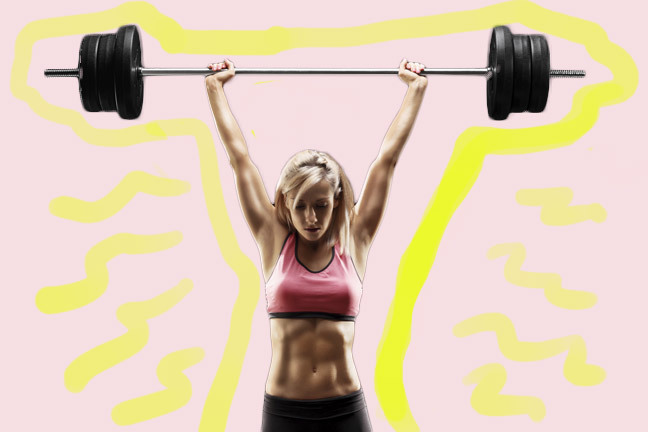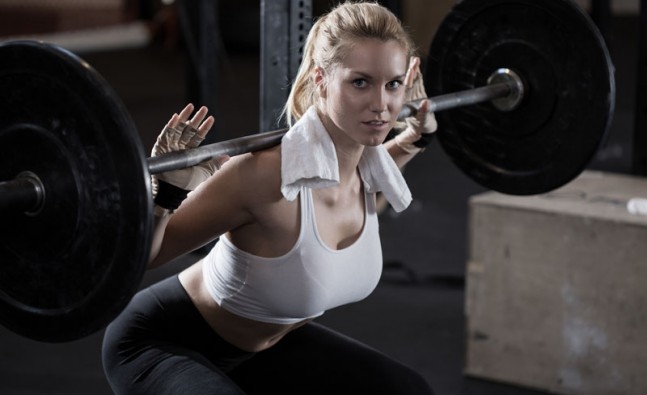Why Women Need to Stop Being Afraid of Lifting Weights | YouBeauty

We all know that woman who refuses to lift weights, because she’s afraid she’ll immediately morph into Vin Diesel. Or maybe you are that woman, the one who runs from the free weights and arm machines at the gym for fear that just looking at them will make your triceps bulge. Confession: that was me for a very long time and it’s time we set the record straight: Lifting weights will not make you bulk up.
“That’s a myth. We don’t have enough testosterone,” explained Beth Lewis, master trainer at Clay Health Club & Spa in New York. “When a man lifts, he has the ability to get pretty big and bulky, but we don’t unless taking anabolic steroids.” Only about 1% of the female population will actually experience bulking with exercise, due to high levels of testosterone.
“A lot of women are petrified of becoming bulky, so it is my mission with all of my female patients to show them that it’s OK to lift heavy weights,” explained Lewis. Actually, she noted, lifting can do the opposite of bulking: It makes you leaner and smaller as you simultaneously build muscle tissue and burn fat. After lifting, your body continues to burn calories for 24 to 48 hours, giving your metabolism a little extra kick and increasing weight loss.
Lifting, in its most basic function, also creates strength and endurance. When your body is stronger and more capable, it makes running and cycling and rowing (or whatever your exercise of choice is) much easier to do. It’s also great for improving bone density, which is a problem many women run into as they age.
Don’t go too easy on yourself, either.: When you lift weights that are too light, you’re losing out on lifting’s full array of benefits. Lewis notes that many of her female clients make a beeline for 3-pound weights. “If you do a set of 10, you’re really not creating the stress on the muscle that allows you to build it,” she said. Most women gravitate toward cardio, too, but the best combination to boost your fitness level and burn body fat is to pair weight lifting with high intensity cardio. You can’t spot reduce (meaning, you can’t just target one area of your body), so you need a full-body approach to see and feel results.
“Higher reps, lower weights is better for muscle endurance (i.e. weighted jumping jacks), but to build muscle, you have to lift a little heavier,” Lewis eplained. So how heavy do you go? “Lift weight where you can only get 8-10 reps out, and the last 2 or 3 should be a really hard push but do-able.” Aim to do either 3 sets of 10 or 4 sets of 8.
If you’re a first-timer, it might not be a bad idea to have a few sessions with a trainer to make sure you’re following proper form so you don’t hurt yourself. But always pay attention to what your body is telling you: If you feel a sharp pain, stop what you’re doing immediately. “Always go for quality over quantity, both in weight and number of reps,” Lewis advised. You can even start on the lighter side, to make sure your technique is on point. When you know you’re going throught he movements correctly, start to increase the weight.
After you’re done, make sure to load up on the right nutrients (carbs, protein, and a little bit of fat) to refuel and rebuild your muscles. (Check out these great post-workout snack ideas.)
Lifting challenges your entire body, and improving your balance and coordination on top of all the other ways it’s changing your body. “You need those skills to walk through life with grace,” Lewis adds. If you start making lifting a part of your routine now, it’ll be a skill you can use the rest of your life to improve yourself inside and out.Below, Lewis demos a few great strength training exercises to try at home or the gym.
-
Brooke Burkes healthy family breakfast shakes
-
How Food Network Star Kelsey Nixon Lost 20 Pounds While in Culinary School
Its one of the questions she hears over and over again: How does Kelse
-
Vital vitamins that will help you lose stubborn weight
-
Diet Soda and Weight Gain
ABC News reported yesterday that diet soda sales have dropped sev
-
Enjoy comfort foods without getting fat
-
4 Best Ways Tamarind Helps You To Lose Weight
Have you ever seen yourself in the mirror and got frustrated with thos
- DON'T MISS
- 26 Effective Tips To Get Rid Of Cellulite Fast
- I Overhauled My Eating Habits and Lost More Than 150 Pounds
- Are you feeling left out on your diet?
- 10 GYM-LESS WEIGHT LOSS TIPS
- My Favourite Weight-Loss Recipes: Fruit salad
- 6 Skinny secret grocery shopping tips
- How This Former College Athlete Got Her Body Back After Having Two Babies
- The Epol Diet
- 10 Best weight loss tips from Doctor Oz
- Does stress cause weight gain?




